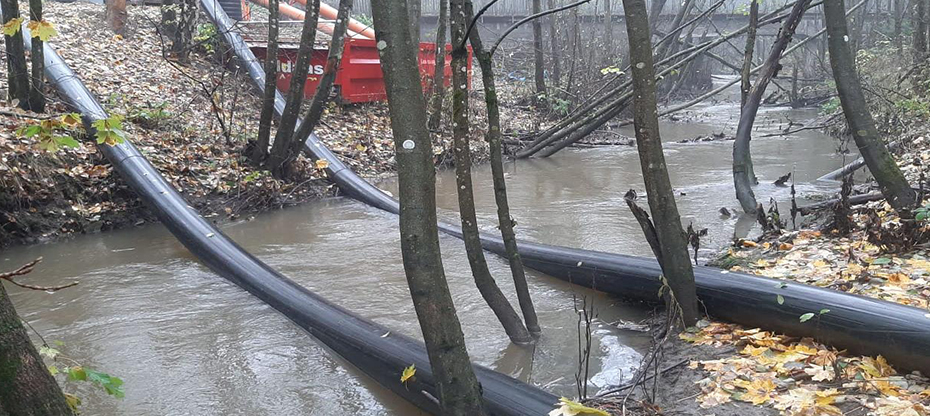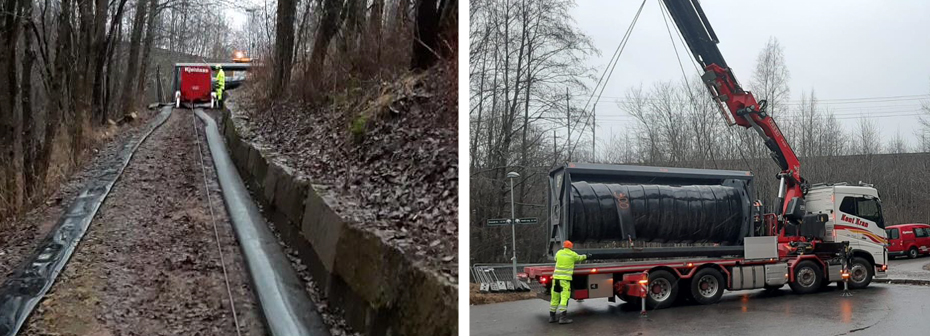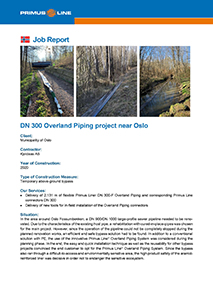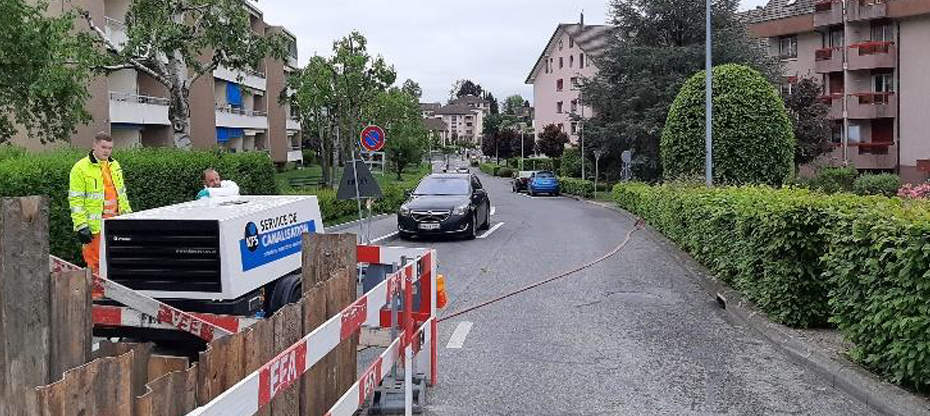Client:
Municipality of Oslo
Contractor:
Kjeldaas AS
Year of Construction:
2020
Type of Construction Measure:
Temporary above-ground bypass
Our Services:
• Delivery of 2,131 m of flexible Primus Liner DN 300-F Overland Piping and corresponding Primus Line connectors DN 300
• Delivery of new tools for in-field installation of the Overland Piping connectors
Situation:
In the area around Oslo Fossumbekken, a DN 900/DN 1000 large-profile sewer pipeline needed to be reno vated. Due to the characteristics of the existing host pipe, a rehabilitation with cured-in-place-pipes was chosen for the main project. However, since the operation of the pipeline could not be completely stopped during the planned renovation works, an efficient and safe bypass solution had to be found. In addition to a conventional solution with PE, the use of the innovative Primus Line® Overland Piping System was considered during the planning phase. In the end, the easy and quick installation technique as well as the reusability for other bypass projects convinced the end customer to opt for the Primus Line® Overland Piping System. Since the bypass also ran through a difficult-to-access and environmentally sensitive area, the high product safety of the aramid-reinforced liner was decisive in order not to endanger the sensitive ecosystem.
Technical Details:
Application: Above-ground bypass
Transported Fluid: Residential waste water
Needed Bypass Performance: up to 300 l / sec
Operating Pressure of Primus Line® system: 1.5 bar
Primus Line® System: DN 300-F medium pressure
Total Length: 2 sections of 1,050 m (total 2,100 m)
Number of Sections: 2 parallel bypass lines
Deployment period: May – December 2020
Rehabilitation System:
Primus Line® Overland Piping is a safe and reliable temporary above-ground bypass solution, suitable for various fluids like residential or industrial waste water, saline water, sea and raw water. The high-pressure liner has a TPU inner and outer coating as well as a seamlessly woven aramid core. Leak-proof end connectors complete the system, making it an ideal solution when working in sensitive environments. Primus Line® Over-land Piping is designed for numerous deployments with a design life of 20 years. The eco-friendly solution convinces with rapid installation, even in difficult terrain without large access roads. As usual with all Primus Line products, installation lengths of 1,000 m and more as well as multiple changes of direction are feasible.
Project Description:
In total, a bypass performance of up to 300 l / sec had to be managed during the renovation works. For this purpose, two parallel sections of DN 300 Primus Line® Overland Piping were installed, which were operated only during the actual construction work from Mondays through Fridays. On days with no construction work or heavy rainfalls, the existing line was operated. This approach enabled an optimal, fast and safe implementation of the project from both an economic and an ecological point of view.
The liner was laid out directly from the reel into the terrain. After a rope connection has been established between the winch and the location of the reel, the flexible liner was pulled over the site. The liner was protected during deployment from damages due to natural obstacles such as trees. The goal is a quick installation that is gentle on both the material and nature. Changes of direction within the course of the bypass can be fixed by posts.
After laying out the liner, the pull-proof connectors were installed. This enabled the connection of the bypass to the existing line and the pumps respectively.
The Overland Piping connectors are based on the well-known and proven Primus Line end fittings, which can be set quickly in the field with hand-held tools. After connecting the bypass, it is ready for use immediately.
Bypass dismantling and reuse:
The dismantling of the bypass liner takes place in the reverse order to the installation. After the liner has been rinsed with water as well as cleaned and emptied using e.g. a foam ball, the Primus Line connectors can be cut from the liner. The connector components (connector core and external sleeve) can later be separated from each other using a mechanical press and can then be reused for future projects.
The liner is pulled out of the inaccessible terrain by means of a winch and recoiled onto the reel using the electrical drive of the transport unit (standing reel procedure). In areas with better accessibility, also moveable reel units (e.g mounted on a bobcat) can be used to recoil the liner (moving reel procedure).
After the liner has been rolled up on the reel again, the bypass material can be easily stored until the next project and is immediately available for further use.









